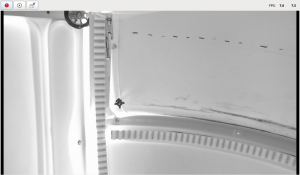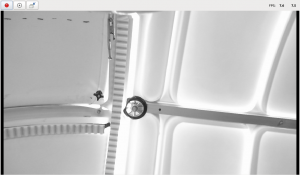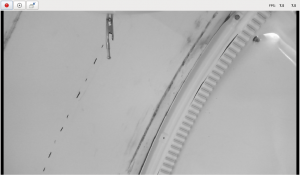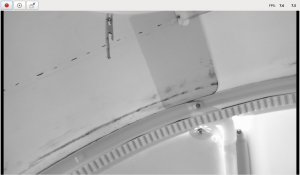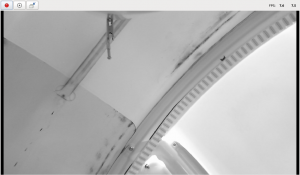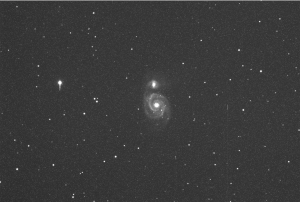 A relatively clear, altho somewhat murky night last night with poor seeing, this is the first long exposure attempted with the ST10XME attached to the TOA-130 mounted on the EQ8. Taken thru the L filter, guided using the guide chip in the ST10. This is a 5 minute exposure on M51 with no calibration, just a mild stretch for screen display.
The evening started off on the wrong foot. Yesterday afternoon in daylight I changed all of the camera connections so that the nosepiece was removed, the Tak camera angle adjuster added, and all connections threaded to get a solid mount on the camera. After dusk, I discovered there was not enough back travel to get the system focussed. I ended up taking it all apart in the dark and inserting an extension tube, then re-assembling it all. When I got everything remounted correctly, I forgot to turn on the camera cooler, so the above image is uncooled.
The ST10 is an NABG camera, so there is one bright star that produces blooms. NABG is desireable for science observations, but, not so much when making ‘pretty pictures’. It remains to be seen if we stick with this camera or change the camera for this telescope.
A relatively clear, altho somewhat murky night last night with poor seeing, this is the first long exposure attempted with the ST10XME attached to the TOA-130 mounted on the EQ8. Taken thru the L filter, guided using the guide chip in the ST10. This is a 5 minute exposure on M51 with no calibration, just a mild stretch for screen display.
The evening started off on the wrong foot. Yesterday afternoon in daylight I changed all of the camera connections so that the nosepiece was removed, the Tak camera angle adjuster added, and all connections threaded to get a solid mount on the camera. After dusk, I discovered there was not enough back travel to get the system focussed. I ended up taking it all apart in the dark and inserting an extension tube, then re-assembling it all. When I got everything remounted correctly, I forgot to turn on the camera cooler, so the above image is uncooled.
The ST10 is an NABG camera, so there is one bright star that produces blooms. NABG is desireable for science observations, but, not so much when making ‘pretty pictures’. It remains to be seen if we stick with this camera or change the camera for this telescope.
First Light
After spending the better part of a month taking what bits of time were available to sort out issues with focusser, cameras, back focus and dome synchronization, the observatory is now functional.
 A relatively clear, altho somewhat murky night last night with poor seeing, this is the first long exposure attempted with the ST10XME attached to the TOA-130 mounted on the EQ8. Taken thru the L filter, guided using the guide chip in the ST10. This is a 5 minute exposure on M51 with no calibration, just a mild stretch for screen display.
The evening started off on the wrong foot. Yesterday afternoon in daylight I changed all of the camera connections so that the nosepiece was removed, the Tak camera angle adjuster added, and all connections threaded to get a solid mount on the camera. After dusk, I discovered there was not enough back travel to get the system focussed. I ended up taking it all apart in the dark and inserting an extension tube, then re-assembling it all. When I got everything remounted correctly, I forgot to turn on the camera cooler, so the above image is uncooled.
The ST10 is an NABG camera, so there is one bright star that produces blooms. NABG is desireable for science observations, but, not so much when making ‘pretty pictures’. It remains to be seen if we stick with this camera or change the camera for this telescope.
A relatively clear, altho somewhat murky night last night with poor seeing, this is the first long exposure attempted with the ST10XME attached to the TOA-130 mounted on the EQ8. Taken thru the L filter, guided using the guide chip in the ST10. This is a 5 minute exposure on M51 with no calibration, just a mild stretch for screen display.
The evening started off on the wrong foot. Yesterday afternoon in daylight I changed all of the camera connections so that the nosepiece was removed, the Tak camera angle adjuster added, and all connections threaded to get a solid mount on the camera. After dusk, I discovered there was not enough back travel to get the system focussed. I ended up taking it all apart in the dark and inserting an extension tube, then re-assembling it all. When I got everything remounted correctly, I forgot to turn on the camera cooler, so the above image is uncooled.
The ST10 is an NABG camera, so there is one bright star that produces blooms. NABG is desireable for science observations, but, not so much when making ‘pretty pictures’. It remains to be seen if we stick with this camera or change the camera for this telescope.
 A relatively clear, altho somewhat murky night last night with poor seeing, this is the first long exposure attempted with the ST10XME attached to the TOA-130 mounted on the EQ8. Taken thru the L filter, guided using the guide chip in the ST10. This is a 5 minute exposure on M51 with no calibration, just a mild stretch for screen display.
The evening started off on the wrong foot. Yesterday afternoon in daylight I changed all of the camera connections so that the nosepiece was removed, the Tak camera angle adjuster added, and all connections threaded to get a solid mount on the camera. After dusk, I discovered there was not enough back travel to get the system focussed. I ended up taking it all apart in the dark and inserting an extension tube, then re-assembling it all. When I got everything remounted correctly, I forgot to turn on the camera cooler, so the above image is uncooled.
The ST10 is an NABG camera, so there is one bright star that produces blooms. NABG is desireable for science observations, but, not so much when making ‘pretty pictures’. It remains to be seen if we stick with this camera or change the camera for this telescope.
A relatively clear, altho somewhat murky night last night with poor seeing, this is the first long exposure attempted with the ST10XME attached to the TOA-130 mounted on the EQ8. Taken thru the L filter, guided using the guide chip in the ST10. This is a 5 minute exposure on M51 with no calibration, just a mild stretch for screen display.
The evening started off on the wrong foot. Yesterday afternoon in daylight I changed all of the camera connections so that the nosepiece was removed, the Tak camera angle adjuster added, and all connections threaded to get a solid mount on the camera. After dusk, I discovered there was not enough back travel to get the system focussed. I ended up taking it all apart in the dark and inserting an extension tube, then re-assembling it all. When I got everything remounted correctly, I forgot to turn on the camera cooler, so the above image is uncooled.
The ST10 is an NABG camera, so there is one bright star that produces blooms. NABG is desireable for science observations, but, not so much when making ‘pretty pictures’. It remains to be seen if we stick with this camera or change the camera for this telescope.




